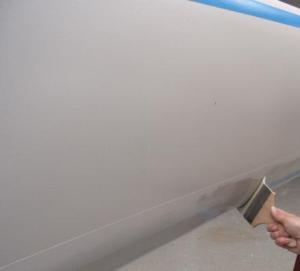Wind turbines need to have a service life of 20 years in order to be economically efficient. This means that they need to be robust. BASF has now developed a paint that protects rotor blades even better, especially on the edges. RELEST® Wind LEP technology offers four times higher resistance than conventional solutions.
 Rotor blade coating is performed in a variety of ways depending on the manufacturer, for instance, by hand with brushes, rollers or spraypainting. The new BASF-paint can be used with all of these methods.
Rotor blade coating is performed in a variety of ways depending on the manufacturer, for instance, by hand with brushes, rollers or spraypainting. The new BASF-paint can be used with all of these methods.
Wind turbine rotor blades are exposed to enormous stresses. At the blade tips, speeds can reach up to 300 kilometers per hour. Add to that the impacts of rain, hail, snow, sand and UV radiation. The rotor blade edges are most vulnerable to impacts. This is because the rotor blades – generally 40 to 60 meters long and in many cases even up to 90 meters long – consist of parts that have been joined together. The glued seam runs along the blade edge. “To protect the edges from erosion, sand and water, we have developed the new product RELEST® Wind LEP. This new generation of polyurethane coating protects this sensitive area of the rotor blade even better,” explained Dr. Harald Müller, Technology Management for Post-Coatings at BASF.
Rain erosion resistance tests have demonstrated the paint’s superior protective function. RELEST® Wind LEP has achieved results that are up to four times better than conventional solutions currently available on the market. To test rain erosion resistance, BASF uses a rain erosion test apparatus at its Oldenburg site. The device supplies data that simulate reality. The test specimens rotate on special mounts in the testing stand and can reach speeds of 500 kilometers per hour. At this speed, water drops are introduced into the test stand (around 30 liters per hour) so that they hit the test specimens. This experimental design creates conditions that are very similar to those real rotor blades are subjected to.
Creating optimum protective properties and allowing easy application were both priorities during development. “The product has to fit our customers’ individual needs. Rotor blade coating is performed in a variety of ways depending on the manufacturer, for instance, by hand with brushes, rollers or spraypainting. The paint can be used with all of these methods,” Müller said. Other advantages of the paint include the fact that the product can be applied under a wide range of climate conditions and that despite the elasticity of the coating, it can be sanded, for example, for touch-up jobs.
Apart from edge protection, BASF offers other RELEST® coatings for rotor blades. All parts of the system, which includes gelcoat, putty, edge protection and topcoat, consist of solvent-free, two-component polyurethane compounds and comply with current VOC regulations. With its RELEST® Wind RepKit, BASF also offers refinish solutions for minor damage to the finish.
About the Coatings Division
In the Coatings Division, BASF develops, produces and markets a high-quality range of innovative automotive OEM coatings, automotive refinishes and industrial coatings as well as decorative paints. BASF has significant market positions in the Coatings sector in Europe, North America, South America and the Asia Pacific region. In 2012 t he Coatings Division of the BASF Group achieved global sales of nearly 3,0 billion Euros. The internet address is www.basf-coatings.com . You can download a copy of BASF customer magazine Coatings Partner from www.coatingspartner.com